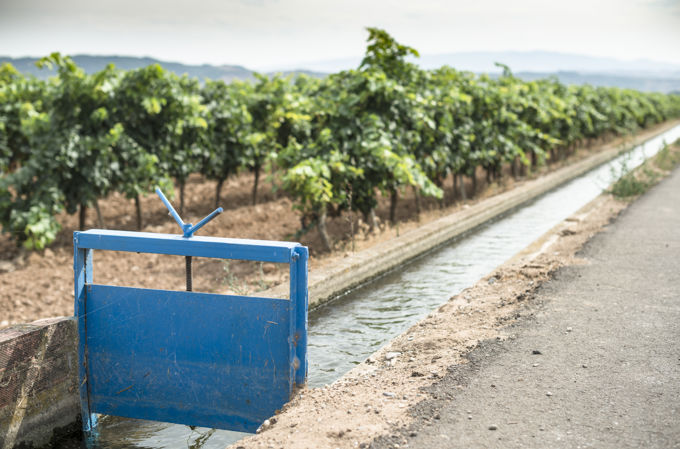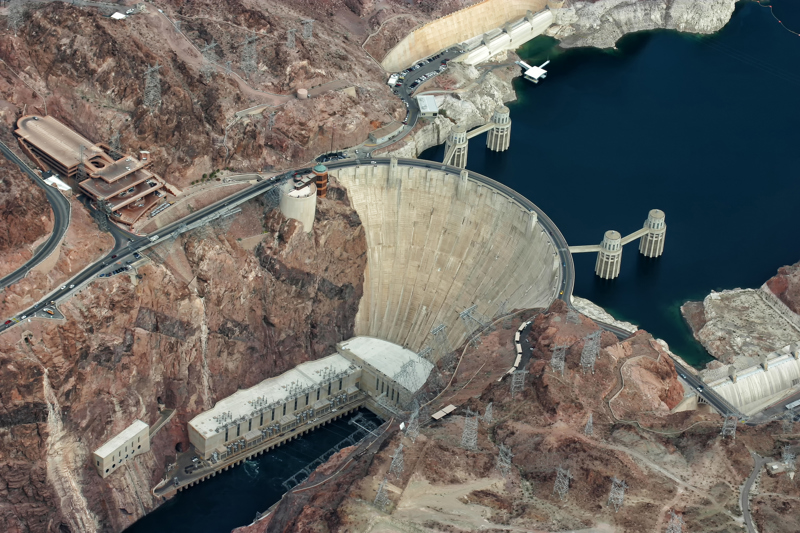
Surface Water Withdrawal and Riparian Property Rights
Riparian Property Rights Allow Withdrawal of Up to 10,000 Gallons of Water Per Day From a River Free of Charge and Without Need of a Virginia Water Protection Permit Issued by the Virginia Department of Environmental Quality
We recently helped a client who asked if she needed a permit to withdraw water from the river adjoining her property. She wanted to use the river water to fill a large inland pond located on her land. In this article we will answer her question by looking to Virginia law on riparian property rights, together with the Virginia Water Protection (“VWP”) Program.

Hoover Dam is an example of a “nonconsumptive use” because it withdraws water from and then returns it to the Colorado River. (Claude Huot / Shutterstock.com)
Surface Water Withdrawal Is One of the Five Riparian Property Rights In Virginia Law
As I explained in a companion article on this blog, riparian property rights under Virginia law consist of five specific benefits. Waterfront property owners enjoy these benefits unless a prior owner in the chain of title conveyed those rights to another person (i.e. “severed” the riparian property rights and sold them) and, further, so long as the rights were not compromised or lost outright through adverse possession (we most commonly see this in our practice when a waterfront owner takes no action after someone builds a pier in his riparian area). Assuming that the riparian property rights remain fully intact at the property, the particular benefit of interest to our client is “the right to make a reasonable use of the water as it flows past or washes upon the land”.
Riparian owners in Virginia put water to a variety of uses as it flows past or washes upon their land, including various nonconsumptive uses. Examples include using the water as an energy source to drive hydroelectric generation, a water wheel that operates a sawmill or a gristmill, or using the water to cool an industrial operation. Riparian owners in Virginia also put flowing water in a river to various consumptive uses. Examples of these consumptive uses include diverting water for domestic uses such as drinking, washing, cooking and bathing. Agriculture provides another example of consumptive use – when river water is used to irrigate crops or to water livestock. In our client’s situation, she proposed a consumptive use, namely she wanted to remove water from the river to fill a large inland pond on her property.
How Virginia Courts Apply Riparian Property Rights to Surface Water Withdrawal
Downstream riparian property owners have called on the Virginia courts many times through the years to measure the degree to which the upstream riparian property owner can withdraw river water that the downstream riparian property owner would like to use. Recall that we are focusing on one of the five riparian property rights, namely “the right to make a reasonable use of the water as it flows past or washes upon the land”. In these cases the court judges “reasonableness” as the litigants argue over competing uses of water. In one such case the Virginia Supreme Court explained:
The governing principle of law in a case like the present is this: A proprietor may make any reasonable use of the water of the stream in connection with this riparian estate and for lawful purposes within the watershed, provided he leaves the current diminished by no more than is reasonable, having regard for the like right to enjoy the common property of other riparian owners. If he diverts the water to a point outside the watershed or upon a disconnected estate, the only question is whether there is actual injury to the lower estate for any present or future reasonable use. The diversion alone, without evidence of such damage, does not warrant a recovery even of nominal damages.
Virginia Hot Springs Co. v. Hoover, 143 Va. 460, 467, 130 S.E. 408, 410 (1925). The Virginia Hot Springs court held that the diversion by the upstream user “greatly damaged” the downstream farmers, hence the diversion was unreasonable.
The Virginia Supreme Court re-affirmed this “reasonableness” principle in 1940 but stated that diversion of water for domestic purposes or to water cattle is an exception to the “reasonableness” requirement. There, the Court wrote:
each riparian proprietor has ex jure naturae an equal right to the reasonable use of the water running in a natural course through or by his land for every useful purpose to which it can be applied, whether domestic, agricultural or manufacturing, providing it continues to run, after such use, as it is wont to do, without material diminution or alteration and without pollution; but he cannot diminish its quantity materially or exhaust it (except perhaps for domestic purposes and in the watering of cattle) to the prejudice of the lower proprietors, unless he has acquired a right to do so by grant, prescription or license.
Hite v. Luray, 175 Va. 218, 225, 8 S.E.2d 369, 371-372 (1940). Cessation of flow for domestic purposes, or to water cattle, is reasonable however where such cessation is needed to sustain life and only in situations where the water in question is the sole source of water. Thus, the court enjoined an upstream user who stopped all flow to a downstream user even though the diversion was based on the need to supply water to cattle. Wilson v. Dressler, 52 Va. Cir. 410 (Cir. Ct. Alleghany County 2000).
How Virginia Water Protection Permits Apply to Surface Water Withdrawal
In the late 1980’s Virginia adopted environmental and natural resource statutes and regulations to supplement the common law with respect to surface water withdrawal.
The regulatory strategy for managing surface water withdrawal in Virginia rests on two broad pillars: (i) water withdrawal reporting; and, (ii) managing the extent and quantity of withdrawals through a permit program.

(Ruud Morijn / Shutterstock.com)
The Virginia Water Protection Program Has a Reporting Requirement for Surface Water Withdrawal
The reporting aspect of the strategy was put in place in 1989 when Virginia enacted Virginia Code §62.1-44.38 which at subsection C provides as follows:
The Board may, by regulation, require each water user withdrawing surface or subsurface water or both during each year to register, by a date to be established by the Board, water withdrawal and use data for the previous year including the estimated average daily withdrawal, maximum daily withdrawal, sources of water withdrawn, and volume of wastewater discharge, provided that the withdrawal exceeds one million gallons in any single month for use for crop irrigation, or that the daily average during any single month exceeds 10,000 gallons per day for all other users.
This code provision, as with many environmental management systems, places a broad mandate on “the Board” (in this case the State Water Control Board) and then relies on the Board, acting through the Department of Environmental Quality (“DEQ”), to adopt implementing regulations. The DEQ codified its regulations for reporting requirements for surface water withdrawals at 9 VAC 25-200-10 to 9 VAC 25-25-200-50. The users who are subject to the reporting requirement are those “whose average daily withdrawal during any single month exceeds 10,000 gallons per day.” 9 VAC 25-200-30(A)(1). Exemptions are available for drydock fillings, certain withdrawals from mines or quarries, and certain withdrawals associated with hydroelectric power generation. 9 VAC 25-200-30(B). According to a DEQ fact sheet, reporting water withdrawal is important because it helps the agency understand what beneficial uses have been sustained from a particular source and what may be supported in the future. Reporting also provides data that the DEQ uses to determine the ability of current water sources to meet future needs.
Our client knew that her daily withdrawals of river water would be less than 10,000 gallons per day. By keeping her withdrawals beneath the 10,000 gallon per day threshold she remains free of the need to report her water withdrawals to the DEQ. In such cases, though, it is prudent to keep a record of withdrawal amounts to protect yourself in the event that a neighbor or downstream user makes a report to the DEQ. If this should happen a DEQ official will have to investigate. If you can show the DEQ regulator your records confirming withdrawals of less than 10,000 gallons per day, he or she will close the investigation and you will be in the clear. A commercial plumbing company or well-drilling company can install a “totalizing” gauge that gives the capability to know how much water was withdrawn on a given day. These companies are very familiar with these gauges and install them routinely.
The Virginia Water Protection Permit Can Regulate Quantity of Surface Water Withdrawal
The second pillar of the statutory and regulatory management of surface water withdrawal is to control the quantity of withdrawals. Virginia Code §62.1-44.15 and §62.1-44.15:22 authorize the VWP permit program to regulate quantity of water withdrawal from surface waters.
The DEQ implementing regulations, found at 9 VAC 25-210-10 to 9 VAC 25-210-610, create the VWP permit program applicable to surface water withdrawals. 9 VAC 25-210-50 requires all persons withdrawing surface water to obtain a VWP permit from the DEQ unless they qualify for an exclusion. The exclusions from the requirement to obtain a VWP permit for surface water withdrawal are found at 9 VAC 25-210-310. Subsection (A)(11) relieves those who withdraw less than 10,000 gallons per day from nontidal waters from the need to obtain a VWP permit from the DEQ (the exclusion for tidal waters is 2,000,000 gallons per day).
Our client owned property on a nontidal river. Similar to the fact that her less-than-10,000-gallon-per-day withdrawal from the river exempted her from the reporting requirement, she was likewise exempted from the requirement to obtain a VWP permit from the DEQ to cover her withdrawal of surface water from the river. Do not lose sight, however, of the need to document the quantity of daily surface water withdrawal, as discussed previously in this article. That documentation will prove useful if a DEQ investigator makes inquiry after a neighbor or downstream riparian owner complains about your surface water withdrawal.
If the VWP permit requirement did apply to our client, she would have initiated the process by submitting a Joint Permit Application (“JPA”) to the Virginia Marine Resources Commission (“VMRC”). As noted on the DEQ website, the VMRC acts as the information clearinghouse for these applications, facilitating concurrent but independent review by local wetland boards, the VMRC, the DEQ and the U.S. Army Corps of Engineers. Our client was very glad to know that she was exempt from the requirement to obtain a VWP permit for her water withdrawal from the river because obtaining this permit is complicated, expensive and time consuming.
Conclusion
We frequently remind clients and our readers that riparian property rights are a substantial, if not the greatest, element of value for waterfront property. A companion article on this blog illustrates the point, a point that is reinforced by the fact that our client, through assertion of her riparian property rights, found that she could withdraw substantial quantities of water from the river that flows past her land free of charge.
